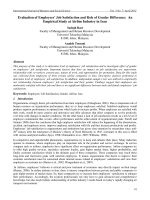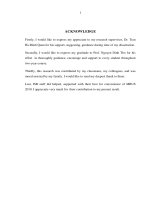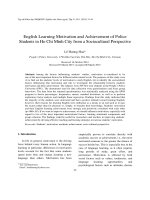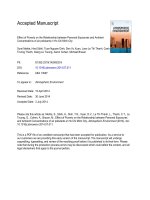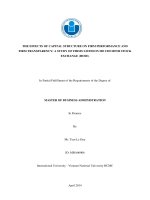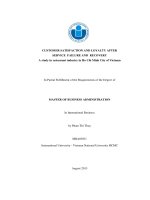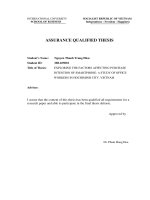Factors affecting job stress and job satisfaction an empirical study of banking industry in ho chi minh city
Bạn đang xem bản rút gọn của tài liệu. Xem và tải ngay bản đầy đủ của tài liệu tại đây (1.39 MB, 101 trang )
UNIVERSITY OF ECONOMICS HO CHI MINH CITY
International School of Business
------------------------------
Truong Thi Chi Thanh
FACTORS AFFECTING
JOB STRESS AND
JOB SATISFACTION:
AN EMPIRICAL STUDY OF
BANKING INDUSTRY IN
HO CHI MINH CITY
MASTER OF BUSINESS (Honors)
Ho Chi Minh City – Year 2015
i
UNIVERSITY OF ECONOMICS HO CHI MINH CITY
International School of Business
------------------------------
Truong Thi Chi Thanh
FACTORS AFFECTING
JOB STRESS AND
JOB SATISFACTION:
AN EMPIRICAL STUDY OF
BANKING INDUSTRY IN
HO CHI MINH CITY
ID: 22130070
MASTER OF BUSINESS (Honors)
SUPERVISOR: Dr. Nguyen Thi Nguyet Que
Ho Chi Minh City – Year 2015
ii
Acknowledgement
I wish to express my sincere gratitude deeply to my advisor, Dr. Nguyen Thi Nguyet
Que. To have completed this thesis, beside my effort, her devoted tutorial has the important
implication. She always helps me to solve trouble, support carefully in order to finish my thesis
in the best way. I always respect and remember these things.
I would like to send my thanks sincerely for Prof. Nguyen Dinh Tho and Dr. Nguyen
Thi Mai Trang because of their value feedbacks from my proposal to draft thesis. It is a
deficiency if I will not remember other teachers teaching me two years ago in ISB. They gave
me knowledge and understanding to have enough ability to perform my thesis and great
foundation to improve my career.
This research was contributed significantly by my friends and my colleagues in the pilot
study and main survey of this study. They also help me when I have difficult in conducting this
thesis. I would like to send my deep thank to them.
I would like to thank my family. I must express my gratitude to my farther and my
mother for their significant moral support during the time when I have conducted this thesis.
Last of all, my sincere thanks are also sent to the staff of ISB supporting me to have the
convenience in last time.
Ho Chi Minh City, December 14th, 2015
Truong Thi Chi Thanh
iii
Abstract
In the development of a country's economy, banking industry plays an important role; it is
the circulatory system of the entire national economy. Vietnam is a developing country in deep
and broad integrating period. Restructuring is the method to strength banking system, increase
the ability to competitive highly and meet the integrating require combining with the
development of country. Therein, human resource management is complex work; the difficulty is
interesting in carefully the harmony of job stress and job satisfaction. Perceiving this issue, some
previous researches in Vietnam mentioned about it. However, they are limitations in the number
of determinants affecting job stress and job satisfaction. While in other developing and developed
countries, new variables were explored and studied meticulously. According to these basic
things, this study aims to explore the effects of role conflict, workload, social support, and role
ambiguity on job stress and job satisfaction. Moreover, it also investigates the relationship
between job stress and job satisfaction in banking industry in Ho Chi Minh City. A sample of
250 fulltime bankers in first line in Ho Chi Minh City was surveyed through questionnaire with
five-point Likert scale to test hypotheses. Multiple regression analysis was suitable to analyze the
data. The results found that in Vietnamese banks, workload and role ambiguity had positive
effects on job stress; social support had the negative effect on job stress. They were significant
relationships. Besides that, this study concluded role conflict, role ambiguity, job stress impacted
job satisfaction negatively and significantly. There was a significant positive relationship
between social support and job satisfaction. Role ambiguity contributed the most influencing on
explaining the determinants of job stress and social support had the most impact on job
satisfaction. However, this study did not find the significant relationships between role conflict
and job stress, between workload and job satisfaction. The achieved findings recommend
essential consultants to improve job satisfaction and reduce job stress in developing human
resource management of Vietnamese banks. However, this research also could not avoid from
some limitations, they are groundwork for further research.
iv
Key words: role conflict, workload, social support, role ambiguity, job stress, job
satisfaction.
v
Table of Contents
Acknowledgement ....................................................................................................................... iii
Abstract .........................................................................................................................................iv
Table of Contents .........................................................................................................................vi
Abbreviations ............................................................................................................................... ix
List of Tables ................................................................................................................................. x
List of Figures .............................................................................................................................. xi
List of Appendices.......................................................................................................................xii
CHAPTER ONE: INTRODUCTION ........................................................................................... 1
1.1 Research background ....................................................................................................... 1
1.2 Problem statement ............................................................................................................ 2
1.3 Research objectives and research questions ..................................................................... 5
1.3.1 Research objectives ................................................................................................. 5
1.3.2 Research questions .................................................................................................. 5
1.4 Research scope ................................................................................................................. 5
1.5 Research significance ....................................................................................................... 5
1.6 Thesis structure ................................................................................................................ 6
CHAPTER TWO: LITERATURE REVIEW ............................................................................... 7
2.1 Theoretical background .................................................................................................... 7
2.1.1 Job satisfaction .......................................................................................................... 7
2.1.2 Job stress.................................................................................................................. 10
2.1.3 Determinants of job satisfaction and job stress ....................................................... 12
2.1.4
Model of Sultan, Tarid, and Rali (2014) ............................................................. 12
2.1.5 Model of Lam (2014) ............................................................................................ 13
2.2 Development of hypotheses and conceptual model ....................................................... 15
2.2.1 Role conflict and its effect on job stress/job satisfaction ...................................... 15
vi
2.2.2 Workload and its effect on job stress/job satisfaction ........................................... 16
2.2.3 Social support and its effect on job stress/job satisfaction .................................... 17
2.2.4 Role ambiguity and its effect on job stress/job satisfaction .................................. 18
2.2.5 Job stress and job satisfaction ............................................................................... 20
2.3 Research model .............................................................................................................. 20
2.4 Chapter summary ............................................................................................................ 21
CHAPTER THREE: RESEARCH METHODOLOGY .............................................................. 22
3.1 Research design .............................................................................................................. 22
3.2 Development of questionnaire ....................................................................................... 23
3.2.1 Measurement scales ............................................................................................... 23
3.2.2. Draft questionnaire ................................................................................................ 26
3.3 Data collection method .................................................................................................. 27
3.3.1 Pilot study .............................................................................................................. 27
3.3.2 Main survey. .......................................................................................................... 28
3.3.2.1 Sample size ...........................................................……………………….28
3.3.2.2
Sampling method ...................................................................................... 29
3.4 Data analysis techniques ................................................................................................ 29
3.5 Chapter summary ........................................................................................................... 31
CHAPTER FOUR: DATA ANALYSIS AND RESULTS ......................................................... 32
4.1 Descriptive analysis ....................................................................................................... 32
4.1.1 Gender ................................................................................................................... 34
4.1.2 Education ............................................................................................................... 34
4.1.3 Age ........................................................................................................................ 34
4.1.4 Salary ..................................................................................................................... 35
4.2 Assessment and refinement of measurement scales ...................................................... 35
4.2.1 The reliability test .................................................................................................. 37
vii
4.2.2 EFA........................................................................................................................ 37
4.3 Multiple regression......................................................................................................... 39
4.3.1 Model 1 - Multiple Regression Analysis with all independent variables and job
stress ............................................................................................................................... 39
4.3.2 Model 2 - Multiple Regression Analysis with all independent variables and job
satisfaction ........................................................................................................................ 42
4.4 Discussion of the results................................................................................................. 45
4.5 Chapter summary ........................................................................................................... 48
CHAPTER FIVE: CONCLUSIONS ........................................................................................... 49
5.1 Conclusions .................................................................................................................... 49
5.2 Contribution of research ................................................................................................. 50
5.2.1 Theory contribution ............................................................................................... 50
5.2.2 Managerial implications ........................................................................................ 51
5.3 Limitations and further research .................................................................................... 53
References ................................................................................................................................... 55
Appendices .................................................................................................................................. 67
viii
Abbreviations
ESCAP
The United Nations Economic and Social Commission for Asia and the Pacific
ACB
Asia Commercial Joint Stock Bank
Vietcombank
Joint Stock Commercial Bank for Foreign Trade of Vietnam
Sacombank
Saigon Thuong Tin Commercial Joint Stock Bank
BIDV
Joint Stock Commercial Bank for Investment and Development of Vietnam
Agribank
Vietnam Bank for Agriculture and Rural Development
SPSS
Statistical Package for Social Science
EFA
Exploratory Factor Analysis
KMO
Kaiser-Meyer-Olkin
ANOVA
Analysis of Variance
KPI
Key performance indicator
ix
List of Tables
Table 2.1 Herzberg’s theory ........................................................................................................ 10
Table 3.1 Measurement scales .................................................................................................... 24
Table 3.2 Findings of qualitative research .................................................................................. 28
Table 4.1 Distribution of respondents based on demographic characteristics ............................ 33
Table 4.2 Cronbach’s Alpha of factor ......................................................................................... 37
Table 4.3 KMO and Bartlett's Test ............................................................................................. 38
Table 4.4 Total Variance Explained ............................................................................................ 38
Table 4.5 Correlations ................................................................................................................. 40
Table 4.6 Model Summaryb ........................................................................................................ 40
Table 4.7 ANOVAb ..................................................................................................................... 40
Table 4.8 Coefficientsa ................................................................................................................ 41
Table 4.9 Correlations ................................................................................................................ .42
Table 4.10 Model Summaryb ..................................................................................................... .42
Table 4.11 ANOVAb ................................................................................................................. .43
Table 4.12 Coefficientsa ............................................................................................................. .43
x
List of Figures
Figure 2.1 Need Tower of Maslow ................................................................................................ 9
Figure 2.2 Conceptual model of the factors influencing workplace stress in UAE banking sector ........ 13
Figure 2.3 Conceptual framework for a study of job stress on job satisfaction among virtual IT workers ........ 14
Figure 2.4 Research model .......................................................................................................... 21
Figure 3.1 Research design diagram ........................................................................................... 23
Figure 4.1 Multiples Regression Result ...................................................................................... 44
xi
List of Appendices
Appendix A: Findings of qualitative research ............................................................................ 67
Appendix B: The English questionnaire ..................................................................................... 77
Appendix C: The Vietnamese questionnaire ............................................................................... 80
Appendix D: Item – Total Statistics ............................................................................................ 83
Appendix E: Rotated Factor Matrix ............................................................................................ 85
Appendix F: Result test assumption for model 1 ........................................................................ 86
Appendix G: Result test assumption for model 2 ....................................................................... 88
xii
1
CHAPTER ONE: INTRODUCTION
1.1 Research background
In 2015, ESCAP identified that Vietnam's economic prospects are facing with a number
of challenges while the difficulty in the banking sector still restrains domestic demand
(Vietnam News Agency, 2015). With Circular No. 36/2014 / TT-NHNN, the banks have to
divest about the regulated level, it will spur the waves of acquisition and merger in the banking
industry (Lê Đình Ân, 2014). To not only overcome these challenges but also develop more
and more stably, one of the requirements identified for banks is improving business activities
combining with managing human resource reasonably. The investment in people is an
important and wise strategy to gain many profits in a competitive market at the present. Tô
Ngọc Hùng (2010) expressed that in many countries, if the development of the banking system
is supported by the commensurate development of human resources, it will create the
sustainability for the banking sector in particular and the economy in general.
Nowadays, because of strengthen finance system, the merging and restructuring in
Vietnamese banks lead to the fluctuations in labors. From 2000 to 2012, the number of
employees reduces significantly. After that, labor demand increases in 2015, demand about
senior personnel in Vietnamese financing – banking sector is about 94.000 people (Nguyễn
Tuấn Anh & Nguyễn Văn Thọ, 2014). In Ho Chi Minh City, Trần Anh Tuấn (2014) predicted
that human resources demand of financing - banking industry in 2020 would be about 11.000
employees. Nevertheless, the problem of banking industry in Vietnam is that facing to human
resource being either deficient or weak (Việt Âu, 2013) and brain draining risk (Mạnh Hòa,
2014). In order to solve above issues, it is very essential to hold on talent employees as a value
source by interesting in employee job satisfaction. Job satisfaction is an important key to decide
the success of an organization. Job satisfaction can be an important indicator of how employees
feel about their jobs. It is vital to enhance the happiness of worker by understanding the
components involving in job satisfaction (Okpara, Squillace & Erondu, as citied in Mustapha,
2013). For the success of banking sector, it is very crucial to handle problems about human
2
resource successfully for the purpose whether the employees are happy. When employees are
happy and satisfied, they often commit to their work and have a good image for the bank
(Bashir & Ramay, 2010). So that, to improve the quality of human resource in banks;
employee’s job satisfaction needs to be interested in thoughtfully.
Moreover, banking industry is the crucial components in the social and economic
development of Vietnam, so job stress in this industry is inevitable in working process of a
banking staff. Job stress is critical thing relating to job satisfaction; especially in the business
sectors requiring the long-term, stable, and high-quality human resource as banking. Khattak
and Iqbal (2013) showed that “the high stress level is practicing in the banking segment.
Banking employees acknowledged that their jobs have been affected by stress. Advanced and
boom up economy, pressure for maintaining the profitability and large and maximized
responsibilities are chief roots causes of the stress” (p. 29).
Therefore, researching the factors affecting job stress and job satisfaction is very
important to be conducted for the banks in Ho Chi Minh City, Vietnam.
1.2 Problem statement
In the world, many studies concerned about the predictors affecting job stress and job
satisfaction; the relationship between job stress and job satisfaction. Rub (2003); Shirey (2004)
proved that social support affects negatively job stress. There is a positive relationship between
social support and job satisfaction (Kozey, 2008; Mintz-Binder & Fitzpatrick, 2009; Kuo-Sue,
2015). According to Ahsan, Abdullah, Fie, and Alam (2009), there are significant relationships
between role conflict, relationship with others, workload pressure, homework interface, role
ambiguity, performance pressure and job stress; they also concluded that job stress has the
negative influence on employee’s job satisfaction. Jahanzeb (2010) had the same result about
the relationship between job stress and job satisfaction. Jahanzeb also showed that job stress is
impacted positively by role ambiguity, role conflict, office politics, and meaningless nature of
work. According to Lam (2010), in United States of America, among virtual workers in
information technology, the correlation between job stress and job satisfaction was defined. He
3
also proved the different levels of job stress based upon the conflict at work, role
ambiguity/conflict, job control, excessive workload, performance pressure, cognitive demands,
non-work activities, social support, skill underutilization, and job satisfaction across the
number of years of virtual work. The most significant factors influencing in job satisfaction
were the skill underutilization, excessive workload and/or variance workload, and role
ambiguity. Similarly; Ram, Khoso, Shah, Chandio, and Shaikih (2011) indicated that job stress
relates highly and negatively to job satisfaction; “the predicted notions that role conflict and
role ambiguity function as job stressors were confirmed in that the higher the experience of role
conflict and/or role ambiguity, the higher the reported work stress” (p. 115).
Khattak and Iqbal (2013) supported that there is a significant positive relationship
between role conflict and job stress while role conflict negatively affects job satisfaction and
lastly job stress mediates between role conflict and job satisfaction. The result in study of
Bemana, Moradi, Ghasemi, Taghavi, and Ghayoor (2013) also illustrated that there is a
negative association between job stress and employee job satisfaction; workload pressure and
performance pressure are factors affecting job stress. In Malaysia, Mustapha (2013) showed
that interpersonal relationship and workload have the impact on job satisfaction. In Iran
municipality personnel, there are relationships between role conflict, workload, performance
pressure, job stress and job satisfaction (Bemana et al., 2013). According to Rizwan et al.
(2014), job stress has a significant positive relationship with role conflict, work overload and
work family conflict but it does not have relationship with role ambiguity in Pakistan banking
sector. Role overload, role ambiguity, and role conflict associate with job stress positively
(Vanishree, 2014).
As mentioned in research background, because Vietnamese banks are facing some
challenges so the quality in the labor, employee job stress and job satisfaction need to be
concerned carefully. Interesting in this reality, previous studies researched about job
satisfaction of staff in not only banking industry but also other different industries. Nguyen
(2011) surveyed 20 State-Owned Enterprises and 20 Non-State Owned Enterprises in Vietnam
4
and found out that organization characteristics have the effect on employee’s job satisfaction.
P. T. Nguyen (2012) concluded that job satisfaction of employees in construction industry is
impacted by demographic variables such as: age, experienced years. Employees being older or
working for a longer time have a higher level of job satisfaction. In education industry, Duong
(2014) found that in Vietnam National University – Ho Chi Minh City faculty members were
moderately satisfied with their job; gender, educational attainment, and country of graduation
were significant differences in job satisfaction. In banking industry, prior studies incisively
concerned on employee job satisfaction. In the result in study of Phan (2011) indicated that
employees working in banking industry are comparatively satisfied with their jobs and working
environments, six major factors influencing in the employees' satisfaction are basic measures
(salary, policies, incentive mechanisms, work pressure and leadership); beside that, others
factors include training, promotion, work behavior and relationship as well as the banks’
working conditions. In Vietnamese banking industry, job satisfaction is positively affected by
human resources practices. They are relationship with management, working environment and
conditions, teamwork spirit (Mai, Nguyen & Nguyen, 2014). Truong (2014) illustrated that the
relationships with superiors and colleagues, advancement opportunities, salaries policy, workitself, fringe benefits, and work conditions are robust factors predicting for the employees’ job
satisfaction. The reality problem is that there is limitation in researching job stress in
Vietnamese banks. In the other hand, although the studies about job satisfaction are quite much,
but the majority is focusing on variable used popular in the long time and the new detection has
not appeared more yet. The researches mentioning role conflict, workload, social support and
role ambiguity in Vietnam are so limited; while in other developing countries and developed
countries has presented above factors like: Malaysia, United States of America, Pakistan, Iran...
; the studies testing the impact of these factors on job stress and job satisfaction are not rare. As
a result, this study is conducted in Ho Chi Minh City in the effort to bridge upon gap.
5
1.3 Research objectives and research questions
1.3.1
Research objectives. This study aims to investigate not only the effect of role
conflict, workload, social support, and role ambiguity on job stress and job satisfaction but also
the relationship between job stress and job satisfaction in banking industry in Ho Chi Minh
City, Vietnam.
1.3.2
1.
Research questions
a. Is there a significant positive relationship between role conflict and job stress?
b. Is there a significant positive relationship between workload and job stress?
c. Is there a significant negative relationship between social support and job stress?
d. Is there a significant positive relationship between role ambiguity and job stress?
2.
a. Is there a significant negative relationship between role conflict and job satisfaction?
b. Is there a significant negative relationship between workload and job satisfaction?
c. Is there a significant positive relationship between support social and job satisfaction?
d. Is there a significant negative relationship between role ambiguity and job satisfaction?
3.
Is there a significant negative relationship between job stress and job satisfaction?
1.4 Research scope
This study was conducted in Ho Chi Minh City – is the biggest economic center and has
the most employees in Vietnam. The timeframe of research lasted from August, 2015 to
September, 2015. Because the force having the most influence on human resource of
Vietnamese banks is first-line employees. In addition, they account for the big portion of labor
and can represent human resource in banks (Nguyễn Hiền, 2015). As a result, the research
object is the fulltime and first – line employees working for banks in Ho Chi Minh City.
1.5 Research significance
In term of theory, this research supplies an empirical understanding the role of factors
influencing in job stress and job satisfaction of employees in banking sector of Vietnam. In
term of practice, this study demonstrates management implications and guidelines to decrease
6
job stress and increase job satisfaction of banking employees in Vietnam. Through that, they
can improve productivity and profit in their organizations.
1.6 Thesis structure
The study consists of five main contents
Introduction (chapter one) includes background (focus on the broad foundations);
problem statement (focus on the real situation of the problem researched with prior studies, the
importance of the study). Besides that, research objectives and research questions; research
scope and research significance are identified.
Literature review (chapter two) recapitulates the content studied in the previous
researches about each factors, previous models. Hypotheses are extracted from review of
literature review. Then, they create cornerstone to build the conceptual model.
Research methodology (chapter three) encompasses research design and development
of questionnaire. From that, this chapter also finds out the method for data collection (pilot
study, main survey) and data analysis.
Data analysis and results (chapter four) uses SPSS 16.0 to analysis data and test
hypotheses. Then, the results from testing reliability, EFA, multiple regression analysis were
illustrated to answer research questions. From that, results are stated with the explanations and
ideas of results
Conclusion (chapter five) summarizes the entire study, explores theoretical
contribution and practical implications from the results achieved. Finally, it specifies the
limitation of this research and recommend for further researches.
7
CHAPTER TWO: LITERATURE REVIEW
Chapter 2 shows a review of the previous studies relating to job stress, job satisfaction,
and the impact of the determinants (role conflict, workload, social support, and role ambiguity)
on them. It also indicates hypotheses and the model for this research. The research model was
built from the review of literature.
2.1 Theoretical background
2.1.1
Job satisfaction. Job satisfaction is a crucial component in human’s life.
According to Vallejo, Vallejo, and Parra (2001), job satisfaction is created by the exchange
between the demands and the expectations of an organization, and of worker’s expectations and
personal objectives. The relationship between workers and organization is reciprocity. The
organization supplies the medium for employees to meet a series of needs and to realize their
personal aspirations. Workers provide for the organization the resources in order to reach
organization’s objectives. Singh and Sinha (2013) indicated that job satisfaction can be
understood as the overall attitude or it can apply to the parts in job of an individual. It can be
identified as an attitude, generally acquired over a period as an employee gains more and more
information about the workplace. According to Mustapha (2013), it is crucial to study
employee’s job satisfaction because this thing is considered as an important factor in enhancing
organizations’ performance and competitiveness. The organizations having high job
satisfaction of employees will increase the productivity of an organization and the
organizational overall performance.
According to Kozey (2008), the composition of job satisfaction included how the
employee feels toward co-workers, pay, benefits, supervision, job description, promotion, and
contingent rewards. He also found:
Consider an employee who is of great value to the organization, but is disgruntled. As
an organization discovering the point of consternation, a better understanding of where
the employee might be disgruntled can help it in figuring out what (if anything) can be
8
changed to accommodate an employee who brings great value to the company. The loss
of talented employees is something that many organizations are actively seeking to
prevent. Job satisfaction and all of the subcomponents of the measure serve as a way to
help organizations in the potential prevention of talent loss value to the company (p. 18).
There are many theories about job satisfaction. This study presented two theories used
commonly and supported for this study more details about the components of job satisfaction
as follow:
Kaur (2013) said that motivational factors have important role in improving employee
job satisfaction. Although commonly understanding in the human motivation literature but
Needs hierarchy theory of Maslow was one of the theories to test the main determinants to job
satisfaction. Maslow Hierarchy of Need is famous for fundamental for most of motivation
theories used job satisfaction to development. This theory built up from satisfactions on
hierarchical ladders of human demand as motivation factors. This theory asserted clearly and
obviously that importance of job-related satisfactions towards activation of employees’
motivation (Kian, Yusoff, & Rajah, 2014). According to Ozguner and Ozguner (2014),
Maslow’s needs hierarchy theory was used to examine the important contributors to job
satisfaction. They are five kinds of need drawn through Need Tower (see Figure 2.1). The
operating principle of this tower is that until the demands of inferior classes as not been
satisfied; it is difficult to continue with upper class. Therefore, to improve job satisfaction,
managers should try to meet the basic demands before progressing to address higher-order
needs. Each kind of demand in Need Tower of Maslow corresponds to each factor and each
level in job satisfaction.
9
Self – Actualization
need
Esteem need
Social need
The needs are
satisfied from low
to high
Safety need
Physiological need
Figure 2.1 Need Tower of Maslow (Ozguner & Ozguner, 2014, p. 213)
Physiological needs: the basic necessities for survival including food, clothes, shelter,
relaxes are met by equal wages or provide meal breaks. If these demands are not met, the staff
will feel dissatisfaction and worry. With this kind of need, employee satisfied at the lowest level.
Safety needs are the demands for favorable working conditions, workplace safety, job
stability, protect the body during work. According to Jandaghi, Mokhles, and Bahrami (2011);
Fatimah, Noraishah, Nasir, and Khairuddin (2012); Jeong (2012); Jain and Jain (2013), job
security is an essential determinant of job satisfaction. Therefore, Maslow’s need for safety
corresponds with job satisfaction by job security. Maslow’s safety need is characterized by
security of body, employment, resources, morality, the family, health, and property. Therein,
economic safety and workplace safety are demands on job security.
Social needs are the needs to communicate with other people to create social
relationships; to interact, affect, affiliate, share, and collaborate with other members of the
organization. The relationships with superiors, colleagues, and subordinates correspond to the
satisfaction about social need in Maslow theory.
Esteem needs are the needs for getting the appreciation, recognition of achievement
from others through the rewards, status, opportunities for advancement. Al-Amri (1994)
showed that Esteem needs are difficult to be satisfied. There two categories of this need:
Internal esteem needs (self-confidence, independence, achievement, importance, competence,
10
and knowledge) and External esteem needs (the needs for status, recognition, and respect from
others). In the study of Nwagwu (2015), self-esteem constructs identified most of the constructs
of job satisfaction.
Self-actualization needs are the highest demands. They are the desire to create, shown
ability, themselves and their performances, aspirations, efforts to achieve its goals. This kind of
need proves for self-efficacy in job satisfaction. Self – actualization is met when employees
satisfied about self-efficacy. They are confident in their ability and potential to perform
different activities related to career planning and development.
According to Stello (2011), An American psychologist - Frederic Herzberg created
Motivation-Hygiene theory in 1959. This theory shows that the behaviors of people are
impacted by two factors independently: Motivation and Hygiene. The effects of two factors on
the attitude of staffs create job dissatisfaction and job satisfaction. Table 2.1 shows the details
of Herzberg’s theory.
Table 2.1
Herzberg’s theory
Factor
Hygiene
Handling well
No handling well
Salary
Work condition
No dissatisfaction
(ko bất mãn)
Dissatisfaction (Bất mãn)
Relationship
Management method
No satisfaction
(Chưa thỏa mãn)
Negative
Promotion
The interest of work
Satisfaction
No satisfaction
Achievement
Implication of job
Positive
No dissatisfaction
Motivation
2.1.2
Job stress. Job stress is a psycho - physiological state appearing when
employee is impacted and attacked intensely by anything in work. According to Beehr and
Newman (1978), job stress is also a situation in which some characteristics of the work
11
situation are thought to cause poor psychological or physical health, or to create risk factors
making poor health more likely. According to Blosser (1999), job stress can be presented as the
harmful physical and emotional responses that happen when the requirements of the job do not
match the abilities, resources, or demands of worker.
Arasli and Tumer (2008) showed that there are many effects of job stress on individual
as well as on the organization. They can lead to lose adaptability and productivity of work,
negative comments, and intention to give up. Malik and Waheed (2010) stated that in the
environment of workplace, job stress is the outlook of individual dysfunction attributable and
the psychological affecting the tight, unfavorable, or unapproachable workplace position. Malik
and Waheed also demonstrated that job stress occurs when the individual does not have the
skills and abilities to perform his/her job effectively, when he/she is not given the proper
training or some necessary resources have not been given to perform the job or when he/she is
confronted with conflicting job demands. It is also identified as the experience of negative
emotional states such as frustration, worry, anxiety and depression attributed to work related
factors, all the stressors working in an individual’s life, job stress is one of the leading causes of
stress. Demands of the workplace may approve harmful to the employee both mentally and
physically (Mustapha, 2013). Job stress is also called occupational stress and generally refers to
the stress that caused by work or factors related to work (Yongkang, Weixi, Yalin, Yipeng &
Liu, 2014). Their study also illustrated that “workplace has become a source of extreme stress
as a result of technological changes, mass retrenchment, information overload, and demand for
greater productivity, fierce competition and uncertain future” (p. 81). Thereupon, employees in
the workplace spend most of their time striving to meet their job obligations and keep pace
with this competitive world. As a result, if managers do not seek out the solution to reduce the
“stressors”, they will have adverse effects on their domestic, social, and personal life. In order
to help employee to gain career objectives in organization, human resources managers should
interest in recruiting the right people – the right job, training them adequately and empowering
to make their decision in order to restrict job stress.
12
2.1.3
Determinants of job satisfaction and job stress. The prior studies explored the
effects on job stress significantly. Rub (2003); Shirey (2004) found out that social support
affects negatively job stress. Moreover, Ahsan et al. (2009) showed that there are significant
relationships between role conflict, relationship with others, workload pressure, homework
interface, role ambiguity, performance pressure and job stress. To support the impact of role
conflict and role ambiguity, Jahanzeb (2010) showed that job satisfaction is impacted
negatively by role ambiguity, role conflict. Role conflict and role ambiguity are functions as
job stressors (Ram et al., 2011). Bermana et al. (2013) stated that workload pressure and
performance pressure influence in job stress. According to Rizwan et al. (2014), job stress has a
significant positive relationship with role conflict, work overload and work- family conflict but
it does not have relationship with role ambiguity in Pakistan banking sector. Vanishree (2014)
showed strongly that role overload, role ambiguity and role conflict are factors influencing in
job stress positively.
About the determinants influencing in job satisfaction, Kozey (2008); Mintz-Binder and
Fitzpatrick (2009); Kuo-Sue (2015) had the same result that there is a positive relationship
between social support and job satisfaction. Ahsan et al. (2009) also presented that the skill
underutilization, excessive workload and/or variance workload, and role ambiguity are the most
significant factors influencing in job satisfaction. Mustapha (2013) expressed that interpersonal
relationship and workload have impact on job satisfaction in Malaysia.
However, there were many studies about role conflict, workload, social support, and role
ambiguity affecting job stress/job satisfaction as above and they also had great implications for
human resource management in the world but the topic seems to be rare in Vietnam. So this
study is implemented to research about these issues in Vietnam and the crucial industry
affecting Vietnamese economics significantly is banking with its urgency and importance to
improve human resource quality.
2.1.4
Model of Sultan, Tarid, and Rali (2014). In previous researches, theoretical
model of Sultan et al. (2014) is the most obvious model concerning deeply about the
13
relationship between predictors (work overload, job ambiguity, lack of control, inter personal
conflict) and job stress (see Figure 2.2). Besides that, they also mentioned the impact of gender,
job category, and age on job stress in banking sector. In the end, they found that job stress has
significant relationship with lack of control, interpersonal conflicts, job category, and age but
job stress is explored not to have significant relationship with work overload, job ambiguity,
and gender classes.
Workload
Job ambiguity
Lack of control
Inter personal conflict
JOB STRESS
Gender
Job category
Age
Figure 2.2 Conceptual model of the factors influencing workplace stress in UAE banking sector
(Sultan et al., 2014, p. 21)
2.1.5
Model of Lam (2010). While model of Sultan et al. (2014) just studied about
the effects on job stress, Lam (2010) studied the influences of predictors on both job stress and
job satisfaction among virtual IT workers (Figure 2.3). As a result, the study confirmed the
different levels of job stress based upon the conflict at work, role ambiguity/conflict, job
control, excessive workload, performance pressure, cognitive demands, non-work activities,
social support, and skill underutilization. The factor having the most significant cause in job
stress was cognitive demands variable. The findings also revealed that the factors predicting on
job satisfaction were the skill underutilization, excessive workload and/or variance workload,
and role ambiguity.
